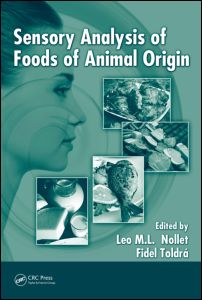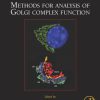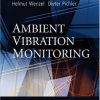Sensory Analysis of Foods of Animal Origin 1st Edition by Leo Nollet, Fidel Toldra 1439847959 9781439847954
$50.00 Original price was: $50.00.$35.00Current price is: $35.00.
Sensory Analysis of Foods of Animal Origin 1st Edition by Leo Nollet, Fidel Toldra – Ebook PDF Instant Download/Delivery: 1439847959, 9781439847954
Full download Sensory Analysis of Foods of Animal Origin 1st Edition after payment

Product details:
ISBN 10: 1439847959
ISBN 13: 9781439847954
Author: Leo M.L. Nollet, Fidel Toldra
When it comes to food selection, consumers are very reliant on their senses. No matter the date on a carton of milk or the seal on the package of meat, how that milk smells and the color of that meat are just as critical as any official factors. And when it comes to meal time, all the senses must conspire to agree that taste, smell, color, and text
Sensory Analysis of Foods of Animal Origin 1st Table of contents:
Part I Meat
1 Color Measurements on Muscle-Based Foods
1.1 General Aspects of Color
1.1.1 Color Attributes
1.1.1.1 Appearance
1.1.1.2 Color as Quality Parameter
1.2 Color Measurement
1.2.1 Objective Methods
1.2.1.1 Reflectance Measurements
1.2.1.2 Near-Infrared Analysis
References
2 Measuring Meat Texture*
2.1 Introduction
2.2 History of Meat Texture Measurements
2.2.1 Warner–Bratzler Shear
2.2.1.1 Development of the Warner–Bratzler Shear Device
2.2.1.2 Standard Protocol for Measuring Warner–Bratzler Shear Force
2.2.2 Other Texture Measurement Systems
2.3 Developments in Meat Texture Measurement
2.3.1 Digital Texture Analyzers
2.3.2 Test Cells, Probes, and Attachments
2.3.2.1 Blades
2.3.2.1.1 Sharp and Blunt Blades
2.3.2.1.2 Razor Blade
2.3.2.2 Needle Arrays
2.3.2.3 Star and Hollow Probes
2.3.2.4 Plumb Bob
2.3.2.5 Nondestructive Deformation Test
2.4 Innovations in Meat Texture Measurement
2.4.1 Isometric Tension
2.4.2 Spectroscopy
2.4.2.1 Near-Infrared Reflectance Spectroscopy
2.4.2.2 Raman Spectroscopy
2.4.3 Sonography
2.4.3.1 Ultrasonics
2.4.3.2 Sonoelasticity
2.4.4 Image Analysis
2.4.5 Electromyography and Electrognathography
2.4.6 Elastography
2.5 Conclusions
References
3 Techniques for Sampling and Identification of Volatile Compounds Contributing to Sensory Perception
3.1 Introduction
3.2 Sampling of Volatiles Available for Sensory Perception
3.2.1 Headspace Sampling
3.2.1.1 Static Headspace Sampling
3.2.1.2 Dynamic Headspace Sampling
3.2.2 In Vitro Sampling (Mouth Analogs)
3.2.3 In Vivo Sampling
3.3 Identification of the Volatile Compounds Contributing to Sensory Perception: GC-O
3.4 Applications to Meat Flavor: Sampling and Identification of Volatiles Contributing to Sensory Perception
3.4.1 Extraction—GC-O
3.4.2 Static Headspace Sampling—GC-O
3.4.3 Dynamic Headspace Sampling—GC-O Analysis
3.4.4 Mouth Analog Sampling—GC-O Analysis
3.4.5 In Vivo Sampling
3.5 Conclusions
References
4 Sensory Descriptors
4.1 Introduction
4.2 Category Scales
4.3 Sensory Descriptive Profiles
4.4 Model Systems
4.5 Conclusion
References
5 Sensory Perception
5.1 Introduction
5.2 Factors Affecting Quality Perception
5.2.1 Consumer Expectations
5.3 Sensory Evaluation and Consumer Studies
5.3.1 Methods Used in Sensory Evaluation
5.3.1.1 Discriminative Tests
5.3.1.2 Descriptive Tests
5.3.1.3 Affective Tests
5.4 Factors Affecting the Sensory Quality of Meat
5.4.1 Type of Meat
5.4.1.1 Chicken Meat
5.4.1.2 Pork Meat
5.4.1.3 Beef Meat
5.4.1.4 Goat Meat
5.4.2 Genetic Factors
5.4.3 Warmed-Over Flavor
5.4.4 Production and Rearing Conditions
5.4.5 Effect of Postmortem Practices, Product Preparation, and Ingredients on Meat Quality
5.5 Influence of the Improvement of Nutritional Value on Sensory Quality
5.6 Concluding Remarks
Abbreviations
References
6 Sensory Aspects of Cooked Meats
6.1 Introduction
6.2 Color
6.3 Texture
6.4 Flavor
References
Part II Processed Meats and Poultry
7 Color Characteristics of Meat and Poultry Processing
7.1 General Aspects of Color
7.1.1 Color Attributes
7.1.1.1 Appearance
7.2 Practical Aspects of Meat Color Measurement
7.2.1 Color Physics
7.2.2 Meat Color
7.2.3 Color during Meat Processing
7.2.3.1 Slaughter
7.2.3.2 Aging
7.2.3.3 Fresh Meat Products
7.2.3.4 Dry-Cured Meat Products
7.2.3.4.1 Dry-Cured Sausages
7.2.3.4.2 Dry-Cured Ham
7.2.3.5 Cooked Meat Products
7.2.3.6 Marinated Meat Products
7.3 Functional Foods
7.3.1 Additives
References
8 Texture Analysis
8.1 Background
8.2 Shear Test
8.3 Penetration
8.4 Single Compression and Texture Profile Analyses
8.5 Tension
8.6 Torsion
8.7 Small Deformation
8.8 Other Noncontact Methods
References
9 Flavor of Meat Products
9.1 Introduction
9.1.1 Flavor Precursors
9.1.2 Flavor Analysis
9.2 Flavor of Cured Meat Products
9.2.1 Bacon
9.2.2 Frankfurter
9.2.3 Cooked Ham
9.2.4 Roast Beef
9.3 Flavor of Dry-Cured Meat Products
9.3.1 Dry- Cured Ham
9.3.2 Dry-Fermented Sausages
References
10 Sensory Descriptors for Cooked Meat Products
10.1 Introduction
10.2 Methods of Descriptive Analysis
10.2.1 Flavor Profile
10.2.2 Texture Profile
10.2.3 The Spectrum™ Descriptive Analysis Method
10.2.4 The Quantitative Descriptive Analysis Method
10.2.5 Quantitative Flavor Profiling
10.2.6 Generic Descriptive Analysis
10.2.7 Free Choice Profiling
10.3 Panel Selection
10.4 Descriptor Development
10.5 Meat Texture Descriptors
10.6 Meat Flavor Descriptors
10.6.1 Mouthfeel Characteristics in Meat Products
10.6.2 Lipid Oxidation and Warmed-Over Flavor in Meat Products
10.6.3 Boar/Sex Taint
10.6.4 Flavor Lexicons
10.7 Odor in Meat Products
10.8 Conclusions
References
11 Sensory Descriptors for Dry-Cured Meat Products
11.1 Introduction
11.2 Dry-Fermented Sausages
11.2.1 Sensory Methods Applied to Dry-Fermented Sausages
11.2.1.1 Flavor Descriptors
11.2.1.2 Sensations and Texture Descriptors
11.2.1.3 Appearance Descriptors
11.3 Dry-Cured Ham
11.3.1 Sensory Methods Applied to Dry-Cured Hams
11.3.1.1 Flavor Descriptors
11.3.1.2 Sensations and Texture Descriptors
11.3.1.3 Appearance Descriptors
References
Part III Fish and Seafood Products
12 Quality Assessment of Fish and Fishery Products by Color Measurement
12.1 Introduction
12.2 Instrumentation
12.3 Novel Method of Color Evaluation
12.4 Color Measurement on Fish and Fishery Products
12.4.1 Aquaculture
12.4.2 Fish Mince, Surimi, and Surimi-Based Products
12.4.3 Processing Effect on Color of Fish and Fishery Products
12.4.3.1 Refrigerated and Frozen Storage
12.4.3.2 Thermal Processing (Heating and Smoking)
12.4.3.3 High-Pressure Processing
12.5 Summary
References
13 Instrumental Texture
13.1 Introduction
13.2 Selection of the Test Procedure and Sample Preparation
13.3 Instrumental Texture
13.3.1 Kramer Test
13.3.2 Warner-Bratzler Test
13.3.3 Puncture Test1
13.3.4 Tension Analysis
13.3.5 Compression Test
13.3.6 Texture Profile Analysis
13.3.7 Viscoelastic Methods
13.3.8 Stress Relaxation Test
13.3.8.1 Creep Test
13.3.8.2 Small Amplitude Oscillatory Test
13.4 Texture Measurement for Quality Assessment
13.5 Conclusion
References
14 Aroma
14.1 Introduction
14.2 Reasons for Studying Fish and Seafood Aroma
14.2.1 Identification of Those Compounds, Which Are Important in Desirable Cooked Fish and Seafood Flavor
14.2.2 Identification of Compounds That Give Undesirable Aroma and Flavor to Cooked and Uncooked Fish and Seafood
14.2.3 Measuring the Effect of Pre- and Postslaughter Treatments
14.3 Sample Preparation
14.4 Aroma Extraction Methods
14.4.1 Solvent Extraction
14.4.2 Steam Distillation and Vacuum Steam Distillation
14.4.3 Simultaneous Distillation/Extraction
14.4.4 High Vacuum Distillation/Solvent-Assisted Flavor Evaporation
14.4.5 Headspace Analysis
14.4.6 Adsorption
14.4.7 Solid-Phase Microextraction
14.4.8 Analysis of Trimethylamine Oxide Breakdown Products
14.4.9 Analysis of Geosmin and 2-Methylisoborneol
14.5 Separation and Identification of Aroma Components
14.6 Quantification of Aroma Components
14.7 Detection of Components of Sensory Significance
14.8 The Electronic Nose
14.9 Future Developments
References
15 Quality Index Methods
15.1 Introduction
15.2 QIM
15.2.1 How to Use QIM
15.2.1.1 QIM Assessors
15.2.1.2 QIM Sessions
15.2.1.3 QIM Results
15.2.2 Development of New QIM Schemes
15.2.2.1 The Raw Material
15.2.2.2 Setting Up the QIM Scheme and Testing the Scheme
15.2.2.3 Validation of the QIM Scheme
15.2.3 QIM in Relation to the EU-Scheme
15.3 Conclusion
References
16 Sensory Descriptors
16.1 Introduction
16.1.1 Sensory Analysis
16.1.2 Objective and Subjective Sensory Analysis
16.2 The Human Senses
16.2.1 The Sense of Vision
16.2.2 The Olfactory Sense
16.2.3 The Sense of Touch
16.2.4 The Gustatory Sense
16.2.5 The Chemical/Trigeminal Sense
16.2.6 The Sense of Hearing
16.3 The Use of Sensory Descriptors
16.4 Sensory Descriptors in Seafood
16.4.1 Appearance
16.4.2 Odor
16.4.3 Taste/Flavor
16.4.4 Texture
References
17 Sensory Aspects of Heat-Treated Seafood
17.1 Introduction
17.2 Seafood
17.2.1 The Anatomy of Shellfish
17.2.2 The Anatomy of Fish
17.2.3 Difference between Fish Species and between Individuals
17.2.4 Handling of Seafood
17.3 Sensory Analysis of Seafood
17.3.1 Assessors
17.3.2 Sessions
17.3.2.1 Test Roo1m
17.3.2.2 Scales
17.3.2.3 Between Samples
17.3.3 Preparation of Heat-Treated Seafood Samples
17.3.3.1 Fish Samples Heat Treated in Oven
17.3.3.2 Fish Samples Cooked in Water Bath
17.3.3.3 Fish Broth
17.3.3.4 Prawns and Shrimps
17.3.3.5 Prawns Broth
17.3.4 Sensory Attributes
17.4 Examples of Sensory Characterization of Seafood
References
Part IV Milk and Dairy Foods
18 Color
18.1 Introduction
18.2 Description of the Techniques in Use in Dairy Food Color Analysis
18.2.1 Color Determination Using Traditional Laboratory Visible Spectrophotometers
18.2.2 Visible and Near-Infrared Reflectance (VNIR) Spectrophotometry
18.2.3 Tristimulus Colorimetry
18.2.4 Spectrophotometers Dedicated to Color Analysis
18.2.5 Color Chart or Color Fan
18.2.6 Computer Vision, Digital Scanning, and Image Analysis
18.2.7 High-Performance Liquid Chromatography (HPLC) of Pigments
18.3 Practical Applications in Dairy Foods Analysis
18.3.1 Anteprocessing (i.e., Milk Production Related to Cattle/Cow Feeding)
18.3.2 Processing
18.3.2.1 Butter
18.3.2.2 Cheese-Making Process
18.3.2.3 Use of Technologies Such as High-Pressure Processing or Ultrafiltration
18.3.2.4 Modification of Dairy Food Composition (Substitution of Milk Powder by Whey Powder or Soy Proteins, Use of Fat Replacers, Addition of Chitosan or Orange’ Fibers…)
18.3.2.5 Studies about the Whiteness of Mozzarella or Browning of the Same Cheese When Used in Pizza
18.3.2.6 Role of the Microflora in the Development of Color at the Surface of Soft Cheeses
18.4 Postprocessing
18.5 Quality Control
18.6 Conclusion
References
19 Texture
19.1 Introduction
19.2 Factors Affecting Texture of Dairy Foods
19.3 Definitions of Texture Parameters
19.4 Texture Profile Analysis
19.5 Texture Measurement of Dairy Foods
19.5.1 Cheese
19.5.2 Butter
19.5.3 Yogurt
19.6 Sensory Measurements
19.7 Viscosity Measurement of Dairy Foods
19.7.1 Capillary Tube Viscometer
19.7.2 Rotational Viscometer
19.8 Selection of Suitable Test for Dairy Foods
References
20 Rheological Properties and Flavor Release
20.1 Introduction
20.1.1 Textural Variety of Dairy Foods
20.1.2 Influence of Rheological Properties on Flavor Release
20.2 How to Characterize Flavor Release?
20.2.1 Mechanistic Approach to Flavor Release
20.2.2 Methods to Measure Diffusion
20.2.2.1 Nuclear Magnetic Resonance and Self-Diffusion
20.2.2.2 Concentration Profiles
20.2.2.3 Diffusion Cell
20.2.3 Methods to Measure Flavor Transfer
20.2.3.1 In Vitro or In Vivo Experiments
20.2.3.2 Static or Dynamic Headspace Measurements
20.3 Influence of Rheological Properties on Flavor Release from Dairy Foods
20.3.1 Gel Model Systems
20.3.2 Yoghurts
20.3.3 Custard
20.3.4 Cheese
20.4 Conclusion
References
21 Flavor Formation
21.1 Brief Introduction to Dairy Flavor Formation
21.2 Flavor Formation in Milk
21.2.1 Milk Flavors Developed During Heat Treatment and Storage
21.2.2 Flavors Developed from the Autoxidation of Milk Lipids
21.2.3 Light-Induced Flavor Formation
21.2.4 Flavor Compounds Derived from Package Component Migration
21.3 Flavor Formation in Fermented Dairy Products: Cheese
21.3.1 Fermentation of Lactose and Conversion of Citrate
21.3.2 Proteolysis and Catabolism of Amino Acids
21.3.2.1 Metabolism of Branched-Chain Amino Acids
21.3.2.2 The Catabolism of Aromatic Amino Acids
21.3.2.3 Methionine and Its Catabolic Pathways
21.3.3 Lipolysis and Catabolism of Fatty Acids
21.4 Concluding Remarks
References
22 Flavor
22.1 Brief Introduction to Dairy Flavor
22.2 Dairy Flavor Extraction Techniques
22.3 Analytical Methodologies for Dairy Products Flavor Investigation
22.3.1 Instrumental Techniques for Analytical Flavor Assessment
22.3.1.1 Gas Chromatography in Dairy Flavor Investigation
22.3.1.2 Gas Chromatography Coupled with Mass Spectrometry
22.3.1.3 Dairy Food Flavor Analysis by Means of Comprehensive Two-Dimensional Gas Chromatography
22.3.1.4 Odor-Activity Assessment by Means of Gas Chromatography- Olfactometry
22.3.1.5 Dairy Flavor Fingerprint Acquisition through Mass Spectrometry
22.3.1.6 Electronic Nose and Tongue in Dairy Flavor Analysis
22.3.2 Sensorial Dairy Flavor Analysis
22.3.2.1 Odor-Activity Value Determination
22.3.2.2 Analytical Sensory Tests
22.4 Characterization of Off-Flavors
22.5 General Considerations on Dairy Flavor
References
23 Determination of Identity and Quality of Dairy Products
23.1 Introduction
23.2 Traditional Techniques Used for Monitoring Cheese Ripening and Determination of the Quality and Authenticity of Dairy Products
23.2.1 Physicochemical Analyses
23.2.2 Liquid Chromatographic Techniques
23.2.3 Gas Chromatographic Techniques
23.2.4 Rheological Techniques
23.2.5 Sensory Analysis
23.3 Spectroscopic Techniques Used for the Determination of the Quality and Authenticity of Dairy Products
23.3.1 Control of Coagulation, Syneresis, and Heat Treatment
23.3.2 Monitoring of Cheese Ripening
23.3.3 Measurements of Cheese Composition, Cheese Rheology, and Sensory Attributes
23.3.4 Cheese Authenticity Determination
23.4 Conclusion
People also search for Sensory Analysis of Foods of Animal Origin 1st:
8 sensory processing systems
6 animal sources 1. sensory organ
4 animals food chain
4 senses of taste
Tags:
Leo Nollet,Fidel Toldra,Sensory,Analysis



